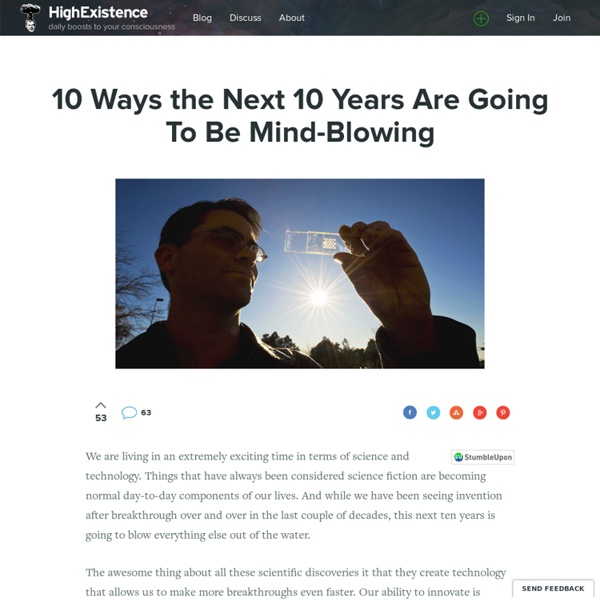10 Ways the Next 10 Years Are Going To Be Mind-Blowing

Higher Perspective | Connect – Reveal – Transcend!
30 Books I’m Glad I Read Before 30
In various ways, these 30 books convey some of the philosophy of how Angel and I live our lives. I honestly credit a fraction of who I am today to each title. Thus, they have indirectly influenced much of what I write about on this site. A medley of both fiction and nonfiction, these great reads challenged my internal status quo, opening my mind to new ideas and opportunities, and together they gave me a basic framework for living, loving, learning and working successfully. If you haven’t read these books yet, I highly recommend doing so. They will enrich your library and your life. Stumbling on Happiness by Daniel Gilbert – Gilbert, a Harvard professor of psychology has studied happiness for decades, and he shares scientific findings that just might change the way you look at the world. What are your favorite books? Photo by: Katie Harris
Next Generation Technology of Flexible Display Future technology
One of the most popular LCD and LED display creator Samsung showcase Flexible AMOLED display. Samsung showcase there next generation AMOLED display at CES 2011. The Flexible AMOLED display is ultra thin sheet that you really can’t imagine. The displays are rollable, bendable and can even survive impacts of a hammer. We surely say that it is really Next Generation display technology by Samsung. Future monitor – SunflowerConcept netbook by lenovoPortable Touchscreen Tablets
untitled
Einstein's Puzzle
# Copyright (C) 2004 Lauri Karttunen # # This program is free software; you can redistribute it and/or modify # it under the terms of GNU General Public License as published by # the Free Software Foundation; either version 2 of the License, or # (at your option) any later version. # This program is distributed in the hope that it will be useful, # but WITHOUT ANY WARRANTY; without even the implied warranty of # MERCHANTABILITY or FITNESS FOR A PARTICULAR PURPOSE. See the # GNU General Public License for more details. Einstein's Puzzle Variations of this riddle appear on the net from time to time. It is sometimes attributed to Albert Einstein and it is claimed that 98% of the people are incapable of solving it. Some commentators suggest that Einstein created such puzzles not to test out intelligence but to get rid of all the students who wanted him as an advisor. Let us assume that there are five houses of different colors next to each other on the same road.
Last Drop : Pumping Up Till The Last Drop From The Bottom of A Bottle |...
The Last Drop concept derived from the inconvenience of pumping up the finishing liquid from the bottom of a shampoo or shower gel container to avoid everyday wastage. The bottom of Last Drop container is designed in a way that the finishing liquids are stored in a cone following by slopes both side where the dispenser can easily reach and let the user to have even the last drop of liquid. The container is beautifully designed to enhance the bathroom décor and lets the user to see how much more liquids are left inside. This product is very helpful for recycling and anti-water pollution with its useful functionalities. Designer : Seonkeun Park and Jinsun Park
نباتات طبيعية ستضيء عتمة منزلك قريباً وبدون كهرباء
عندما نتكلم عادةً عن أشياء مضيئة دون طاقة كهربائية فقد تذهب أذهاننا نحو اللصاقات الصغيرة التي تضيء بألوان فوسفورية ملأت غرفة نومنا في الصغر، وإن توسعت في فكرك قليلاً فقد تنظر إلى القناديل البحرية العجيبة أو بعض القطط الحقيقية التي تتوهج في الظلام، حتى أنك قد تتعرف على أنوار بعض المشروبات التي تضيء كأسك طبيعياً، لكن هل شاهدت يوماً أي من النباتات تسلط النور على حديقة منزلك أو غرفة جلوسك؟ من الآن فإنك ستجد هذا من المألوف مع نباتات Bioglow الهجينة للتعرف على معاني جديدة من الإنارة الذاتية الحية. ما يميز النبتة بأنها قادرة على توليد إضاءة كافية لإنارة جزء كبير من غرفة متوسطة الحجم، لكنها بالتأكيد لن تكون بقوة الأنوار و المصابيح الكهربائية على الأقل حتى الآن، وتستمد نبتة Starlight avatar الهجينة شحنها من خلال النمو في حوض ترابي مزود بمغذيات هلامية التكوين، يمكنك أيضاً نقلها إلى أحواض أخرى عند الرغبة إلّا أنها ستكون عرضة إلى التقليل من فرص حياتها والتي تستمر من شهرين إلى ثلاثة في الحالة الطبيعية، بالإضافة إلى أنه يجب إبعادها تماماً عن أشعة الشمس المباشرة.
free university lectures - computer science, mathematics, physics, chemistry
Whether your goal is to earn a promotion, graduate at the top of your class, or just accelerate your life, lectures can help get you there. Our archives of lectures cover a huge range of topics and have all been handpicked and carefully designed by experienced instructors throughout the world who are dedicated to helping you take the next step toward meeting your career goals. Lifelong learns can turn their free time turn into self-improvement time. The online lectures on this list are more than lecture notes or a slideshow on a topic -- they were designed for audiences like you, with carefully sequenced themes and topics taught by veteran educators, and often with additional resources for your own independent study. The lectures are available to anybody, completely free of charge. Lecture courses are a valid and vital learning tool, and may be one of the best methods of learning available.
Related:
Related:



